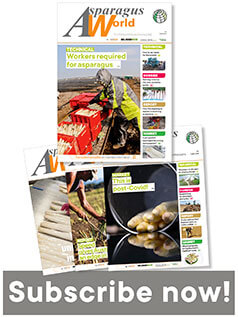Lesotho making renewed bid with asparagus
Lesotho, a high-altitude, landlocked kingdom that is entirely encircled by South Africa, is preparing for another bid to boost its asparagus production. The country boasts many hectares of arable land with the kind of soil and climatic conditions that favour production of excellent fresh green asparagus. Earlier efforts to promote investment in and expansion of asparagus production in the Southern Africa nation were largely unsuccessful. But Kingdom Asparagus co-founders Alex Stainburn, Thuso Green and Khotso Mapepesa believe the time is ripe to try again.
Sandy loams, abundant sun and affordable labour

Lesotho is a mostly mountainous country in Southern Africa and has a population of about 2.33 million. Located at an altitude of 1,400 metres (4,590 ft), it has the distinction of having the highest low point of any country. Although mountainous, there are many hectares of arable land with the qualities necessary to produce great asparagus: sandy loam soils, over 300 days of sun per year, and labour rates that are very competitive in the global market. “Asparagus was grown successfully in Lesotho for a number of years in the 1970s and 1980s for canning, so we are confident that it can be grown again on a commercial scale, for high quality, fresh green asparagus,” Stainburn said. “Our niche consumer is the individual who cares about where their food comes from.” Records from the 1980s show average yields of three tons per hectare without irrigation, but those records are 30-40 years old. “Plant varieties and growing techniques have improved significantly since then. With the addition of irrigation, we should see yield reliability and harvest volumes increase,” Stainburn said. “Starting in 2016, we conducted a series of trials to learn how to grow asparagus specifically in Lesotho; namely how to source labour, and inputs effectively. We found that much of the knowledge from the 1980s has been lost as the former generation of farmers has retired, so farmer training is a big part of our scale-up process,” he said.
There’s local demand in Lesotho

During trials in 2018, 2019 and 2020, Kingdom Asparagus delivered fresh asparagus to local restaurants and to a large grocery store, Pick n Pay, in Lesotho capital Maseru, which asked for 250 gram bundles, Stainburn said. “The spears were cut and bundled in the early morning and delivered within a few hours to the store, where they were bought by customers as soon as they were placed on the shelves. Also, a few Germans who were living in Lesotho at the time contacted us to place a special, bulk order, a good sign to us that our quality was up to standards for discerning tastes,” he said. Starting a new agricultural endeavour in Lesotho has not been without its challenges and detailed planning is the key. “For example, do not expect to find a tractor with a ripper attachment a week before you want to plough – those arrangements should be made during the winter months. Working with local farmers also requires reducing their expected debt burden. Farmers see the potential of asparagus to increase their incomes versus growing a low value crop such as maize, but getting past the high input costs and the first few years of low revenue makes the crop inaccessible to most smallholder growers. Asking a farmer in Africa to take on debt for a few years before any income is realised, usually doesn’t end well,” Stainburn said.
Current and future priorities
Kingdom Asparagus is currently working to expand its area under cultivation. Favourable sites have been identified in the Leribe and Butha-Buthe areas of Lesotho where there are good soil conditions (namely sandy loam soils on flat land) and a potential for irrigation. “We have the need for partners with the expertise and financial capabilities to move our production forward from a local to export focused model. And in case you’re wondering, we usually grill our asparagus. We coat it with a little olive oil, sprinkle on some salt and then cook for 3-4 minutes on the grill. Simple, but the best way to enjoy what we have grown,” he said. The Government of Lesotho recognises the potential of re-establishing asparagus as an export crop, and has expressed a willingness to support expansion of production in whatever ways it can. There are tax incentives for new export based companies, through the Lesotho National Development Corporation, and free movement of currency. Lesotho is also part of many international trade agreements for low income countries, Stainburn said.
Why Lesotho’s earlier asparagus export project failed

Previously a British protectorate, Lesotho gained its independence in October 1966 and is currently classified by the World Bank as a lower middle-income country. Per capita gross domestic product (GDP) was US$999.7 in 2022, a year in which Lesotho’s economy grew by 1.8%, mainly driven by construction, mining, manufacturing, business services, and public administration. Agriculture also contributed positively due to good seasonal rainfalls and input subsidies, according to the World Bank, which also said that unemployment, inequality and poverty remained high in 2022.
In a bid to combat rural poverty back in the 1970s, the government in Lesotho launched a project promoting asparagus production for export to Europe. A cannery was reopened and initially bought asparagus in three grades: white, green and salad.
The project ran from 1974 to 1999 and despite considerable investment (including financing under the UN Capital Development Fund), it encountered many difficulties, ultimately failing to provide sustainable livelihoods for the rural poor.
According to an article in the Journal of Sustainable Development in Africa*, factors closely linked to the unsustainability of Lesotho’s asparagus production project were (a) poor management of production and (b) processing and marketing services that inhibited the expansion of asparagus production and made it impossible for Lesotho’s asparagus to compete effectively in the Western European markets.
Among the various problems leading to the failure of the project was an inability to take advantage of the shift in consumer preferences in Western Europe towards greater demand for fresh asparagus, largely due to lack of air cargo availability.
Read more
Journal of Sustainable Development in Africa (Volume 16, No.6, 2014)
Other sources:
Asparagus Production and Sustainable Rural Livelihoods in Lesotho
























